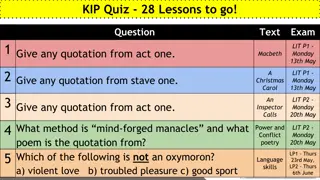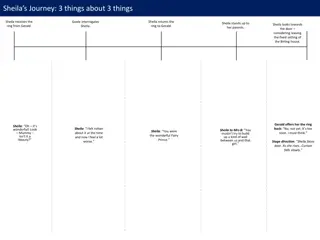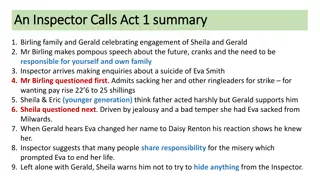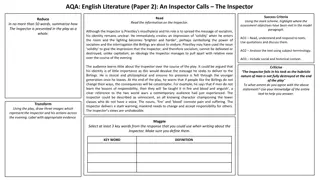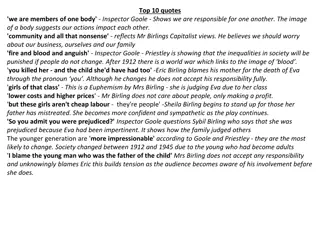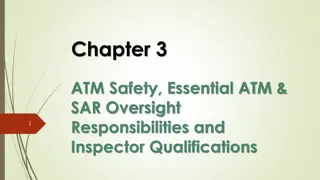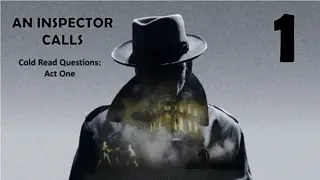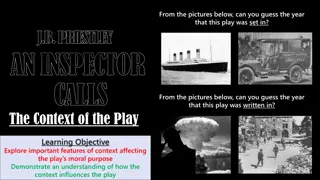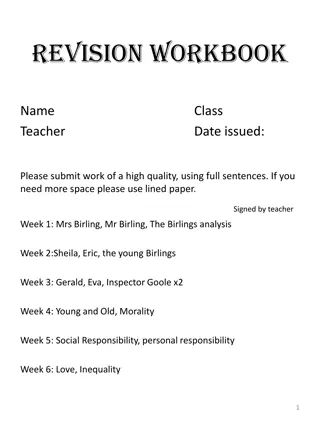
Exploring 'An Inspector Calls' Plot, Characters, and Themes
Dive into the plot, characterizations, settings, and themes of "An Inspector Calls" by exploring key incidents involving the Birling family, including Arthur Birling, Sybil Birling, Sheila Birling, Eric Birling, Gerald Croft, Eva Smith, and Inspector Goole. Discover the dramatic techniques, structure, stagecraft, and themes like social class, social responsibility, and guilt in this compelling play.
Download Presentation

Please find below an Image/Link to download the presentation.
The content on the website is provided AS IS for your information and personal use only. It may not be sold, licensed, or shared on other websites without obtaining consent from the author. If you encounter any issues during the download, it is possible that the publisher has removed the file from their server.
You are allowed to download the files provided on this website for personal or commercial use, subject to the condition that they are used lawfully. All files are the property of their respective owners.
The content on the website is provided AS IS for your information and personal use only. It may not be sold, licensed, or shared on other websites without obtaining consent from the author.
E N D
Presentation Transcript
Kelso High School English Department
Learning Intentions Act One Plot / Key incidents Setting Characterisation The Birling Family / Arthur Birling / Sybil Birling / / Sheila Birling / Eric Birling / Gerald Croft / Eva Smith (Daisy Renton) / Inspector Goole Dramatic Techniques: Tension / Entrances / Exits / Dramatic Irony Structure: Opening Stagecraft: One set / Lighting Themes : Social Class / Social Responsibility / Remorse and Guilt / Reality versus Illusion
Plot / Key Incidents The Birlings are having an engagement party when an Inspector arrives. He tells them that a young woman called Eva Smith has killed herself. It is revealed that Arthur Birling sacked her from his factory. This sets off the chain of events that led to her suicide and all the Birlings are eventually involved. Sheila Birling got her sacked from her new job in a shop.
Setting Birlings dining room. In 1912 only rich families had a dining room this makes it a symbol of the middle class.
Characterisation:The Birling Family
Characterisation: The Birling Family Initially they appear like the perfect family: Arthur Birling is a successful businessman. Sybil Birling works hard to keep the family s reputation intact. Eric Birling works for Mr. Birling in the family business. Sheila Birling is engaged to Gerald Croft, the son of another successful businessman.
Characterisation: Arthur Birling
Characterisation: Arthur Birling Act One Portrayed as a successful and ambitious businessman. He: Treats his daughter s marriage as a business deal as he hopes that his company can join with company owned by Gerald s father to get lower costs and higher prices . Considers himself to be successful, a practical man of business . He is positive about the future, I say there isn t a chance of war . This shows how shortsighted he is.
Characterisation: Arthur Birling Act One He likes to be respected. He is well known in Brumley and likes to tell people he used to be the Lord Mayor, You see I was Lord Mayor here two years ago when the Royal Family visited us . He desperately wants Gerald s family to like him and wants Gerald to tell them about his knighthood.
Characterisation: Arthur Birling Act One He is used to being in charge and the Inspector says only twenty words before Birling shows impatience . He does not care about other people. He doesn t believe in community and all that nonsense . He sees working class people as cheap labour . He didn t just refuse to give the workers better wages he fired the leaders of the strike. He would rather forget about Eva and protect his reputation than face up to what he had done, If you don t come down sharply on some of these people, they d soon be asking for the earth .
Characterisation: Sybil Birling She is very traditional and stuck in her ways about her social class. She is unfeeling and cold, a rather cold woman . She thinks that social position is very important and tries to make her family follow the rules of proper behaviour e.g. telling Sheila off for using slang. She is Arthur Birling s social superior . She tells her husband off for saying the food was good in front of a guest, Arthur, you re not supposed to say such things .
Characterisation: Sheila Birling
Characterisation: Sheila Birling Initially portrayed as child-like: The stage directions say she s very pleased and excited . She uses language like squiffy I m sorry Daddy . She jokes with Gerald, but the stage directions say she s half serious, half playful . Is her childishness a way to hide serious concerns about her relationship with Gerald.
Characterisation: Sheila Birling Her initial treatment of Eva / Daisy could be because she is immature. She is initially portrayed as selfish as she used her social position to get Eva / Daisy fired from the shop. She admits she used her power to punish Eva/ Daisy, but it didn t seem to be anything very terrible at the time .
Characterisation: Sheila Birling She does appear, even as early as Act One to have morals: But these girls aren t cheap labour they re people . At least I m trying to tell the truth . And if I could help her now, I would I ll never, never do it again to anybody .
Characterisation: Sheila Birling She has good instincts: You gave yourself away as soon as he mentioned her name . She realises there is no point in lying to the Inspector: Why you fool he knows. Of course he knows. And I hate to think how much he knows that we don t know yet. You ll see. You ll see .
Characterisation: Eric Birling Hints are dropped that Eric is not quite as he appears: Stage directions say he is, Not quite at ease . He is described as half shy .
Characterisation: Eric Birling When Gerald jokes that the Inspector might be calling because Eric s been up to something , Eric acts suspiciously (who is uneasy, sharply) and says that he doesn t think the joke is very funny . This suggests that he is feeling guilty about something, even though we don t know what he has done until much later. Priestley uses Eric s strange behaviour to hint that he is hiding secrets that will damage the Birling family s reputation.
Characterisation: Gerald Croft Seems like a good catch. He gets on well with Mr Birling and impresses Sybil Birling. He is portrayed as respectable, well-bred young man about town He is portrayed as upper class, from an old country family . He is socially superior to the Birlings.
Characterisation: Gerald Croft He is a younger version of Arthur Birling: He agrees with Mr Birling about politics, women and laughs at his jokes. He is completely business-minded and supports Arthur s sacking of Eva Smith, You couldn t have done anything else We d have done the same thing . He shows that young people are just as self- centred as the older generation
Characterisation: Gerald Croft He is also a liar as he had an affair with Eva Smith the previous summer, but told Sheila he was just busy with work, It was all over and done with last summer. I hadn t set eyes on the girl for at least six months. I don t come into this suicide business .
Characterisation: Eva Smith An ordinary working class girl Eva = similar to Eve the first woman in the Bible she could represent all women. Smith = a very common last name. Could also signify someone who works with their hands e.g. a blacksmith, a locksmith. Her name could mean that she represents all ordinary, working class women. She represents all vulnerable working class people who need the support of a more caring society.
Characterisation: Eva Smith Eva Smith is a silent character who represents the powerless members of society. The Birlings take away her earnings: Act 1 She is sacked from her job as a factory worker at Birling and Company. She was a good worker but sacked for speaking out. Act 1 She is sacked from her job as a shop assistant at Milwards. She is also good at this job, but Sheila gets her sacked out of jealousy.
Characterisation: Inspector Goole He is charge, Be quiet for a moment and listen to me . He arrives near the beginning of the play and says he wants to find out the truth of what happened to Eva / Daisy. He is not bothered about impressing the Birlings so is not worried about how he treats them. He is a strong character and gives an impression of massiveness, solidity and purposefulness .
Characterisation: Inspector Goole He does not behave like the Birlings: He does not play golf and he s not impressed by Birling being a former Lord Mayor. He interrupts, repeats and pauses in unusual ways. He does not behave in the way that the middle classes would have expected
Characterisation: Inspector Goole He is responsible for making the audience feel sorry for Eva: pretty / lively Sympathy is increased by the harsh description of her death, burnt-out inside . He controls the play s actions dealing with one character at a time. The other characters get confused he never does.
Characterisation: Inspector Goole He is an outsider who takes Eva / Daisy s side. Priestley uses the Inspector to present his own views. He is Priestley s voice in the play.
Dramatic Techniques - Tension The Inspector increases the tension by only releasing information bit by bit e.g. showing the photograph to only one person at a time, (Both Gerald and Eric rise to have a look at the photograph, but the Inspector interposes himself between them and the photograph). Priestley freezes the action between scenes to create tension Act One ends with the Inspector asking, Well? which suggests that he knows Gerald has something to confess.
Dramatic Techniques Entrances The Inspector arrives just as Birling says, a man has to mind his own business. It is as though the Inspector has been sent to prove the exact opposite.
Dramatic Techniques Exits When the characters exit they are ususally escaping someone or something e.g. Sheila runs off the stage when she realises that getting Eva / Daisy sacked might have led to her suicide, (Gives a half-stifled sob, and then runs out). The Inspector uses exits to get information out of the other characters e.g. leaves Sheila and Gerald alone together to discuss his affair with Daisy Renton, Eric take the Inspector along to the drawing room .
Dramatic Techniques Dramatic Irony When the audience know something that the characters on stage don t. Birling thinks the future is bright: 1. He says the problems between workers and bosses aren t serious, BUT there was a General Strike in 1926. Millions of people stopped working for nine days. 2. He says that the Titanic is unsinkable , BUT it sank on its first journey.
Dramatic Techniques Dramatic Irony 3. He says that there definitely won t be a war with Germany, BUT World War One was about to start. PRIESTLEY USES DRAMATIC IRONY TO MAKE THE AUDIENCE THINK THAT BIRLING MIGHT BE WRONG ABOUT LOTS OF OTHER THINGS, FOR EXAMPLE, THINKING THAT SOCIAL RESPONSIBILITY IS NONSENSE . In the play it seems as though the Inspector knows everything, Priestley gives a similar power to the audience.
Structure - Opening Exposition introduces us to: 1. Characters 2. Background 3. Context 4. Themes
Structure: Opening Idea that even before the Inspector arrives it is clear that there are problems. Sheila is half-serious, half-playful with Gerald. She already has doubts about him. Eric appears to be half- drunk as he toasts Gerald and Sheila rather noisily this hints at his drinking problem.
Stagecraft - Set The set is cramped (one room) which increases the tension and makes the whole atmosphere of the play seem more intense. The small set shows how self-centred the Birlings are and how unwelcome an outsider (the Inspector) is.
Stagecraft - Lighting Pink at start to reflect the warm and lovely atmosphere. It becomes brighter and harder when the Inspector arrives, symbolising a spotlight being turned on their world.
Theme: Social Class Birling is a rich businessman, but the Crofts are socially superior because they inherited land and money. Eva Smith lost both her jobs because she was abused by more powerful people. They felt more important than Eva because of their social class. Priestley thinks the class system is unfair for working class people Eva Smith could represent any working class member of society.
Theme: Social Responsibility Arthur Birling believes that looking after himself and his family is all that matters, If we were all responsible for everything that happened to everybody we d had anything to do with, it would be very awkward, wouldn t it? He wants to pay his workers as little as possible. He doesn t care about them he just wants to make more money. He refuses to take responsibility for the impact he had on Eva s life. He laughs at the idea of Social Responsibility and calls people like the Inspector, cranks .
Theme: Social Responsibility Eva represents all the vulnerable working class people who need the support of a more caring society. Shelia realises that getting Eva sacked wasn t very responsible, but she didn t do anything about it at the time, It didn t seem to be anything very terrible at the time .If I could help her now, I would -
Theme: Guilt and Remorse Sheila begins to change her attitude even as early as Act One: I ll never, never do it again to anybody . I behaved badly too. I know I did. I m ashamed of it .
Theme: Illusion versus Reality They might appear to an outsider like the perfect family, but even as early as Act One
Success Criteria Plot / Key incidents Setting Characterisation The Birling Family / Arthur Birling / Sybil Birling / / Sheila Birling / Eric Birling / Gerald Croft / Eva Smith (Daisy Renton) / Inspector Goole Dramatic Techniques: Tension / Entrances / Exits / Dramatic Irony Structure: Opening Stagecraft: One set / Lighting Themes : Social Class / Social Responsibility / Remorse and Guilt / Reality versus Illusion





